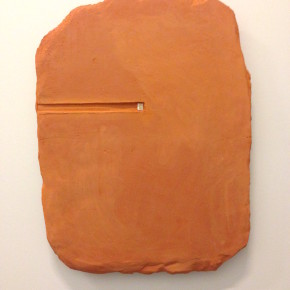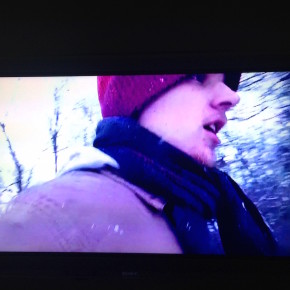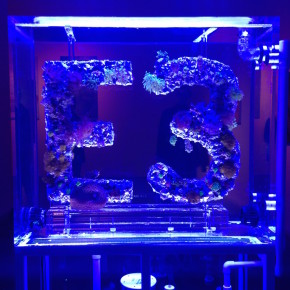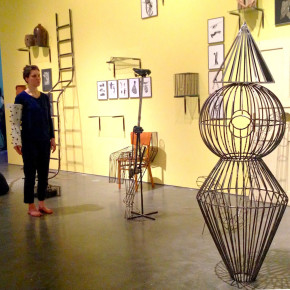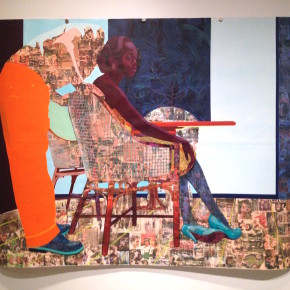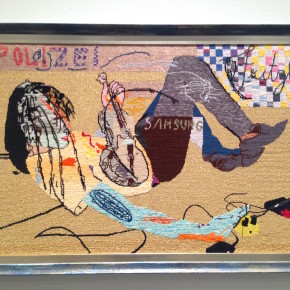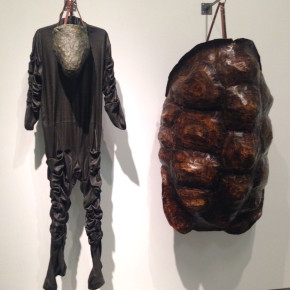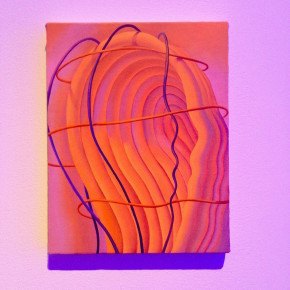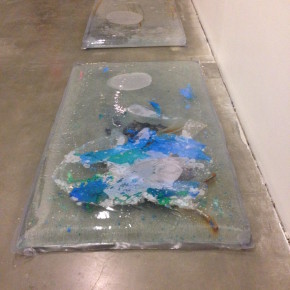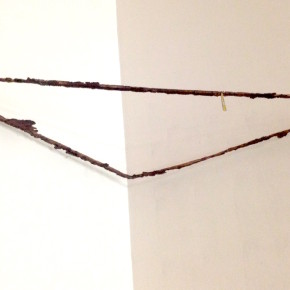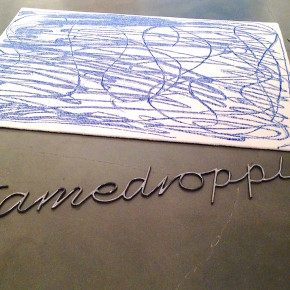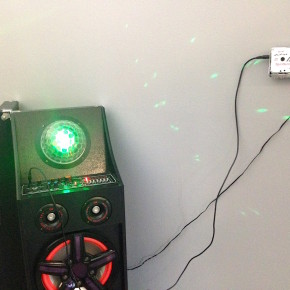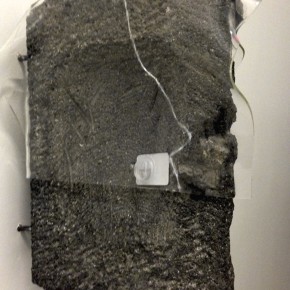
Renaud Jerez, (b.1982, France), B, 2014, Aluminum, cotton, rubber, wooden chair, webcam and sneakers, Artwork courtesy of Galila’s Collective, Belgium, New Museum Triennial, “Surround Audience”, Photo by Katy Hamer, 2015
What are new visual metaphors for the self and subject-hood when our ability to see and be seen is at an all time high? What are the ways that artists are representing themselves but also shrinking from visibility feeling overseen [through social media]? These are just a few of the questions that curators Lauren Cornell and artist turned curator Ryan Trecartin in their 2015 Triennial for the New Museum. Titled Surround Audience the exhibition features fifty-one artists merging the mutual interests of Cornell (formerly of Rhizome) and Trecartin. In a radical move, they have also decided to use many of the non-traditional spaces in the museum such as the stairwells and bathrooms for audio installations, which may not seem pertinent at first is actually quite important since the exhibition is basically inescapable. When those who may normally duck into the bathroom or into a stairwell to text or call a friend, this option is no longer an option as sound variants echo and vibrate off of white walls. The result is actually an innovative change and assists in the curatorial agenda granting the viewer the chance to passively participate in the exhibition beyond that of an Instagram photograph, but rather through a physicality of spatial intervention.
Beyond the sheer enjoyment of living with art, or the use of decorating one’s home or office, throughout time, most art worth considering within a historical and critical context is that which deals with or confronts the human condition. Arguably, this could be said to ring true for all artworks literally representing the human form, or marks of the human hand. Some may consider this concept or way of thinking to be uncool, but what “Surround Audience” addresses are the tertiary components of Post-Internet art; technology, the artists relationship to technology and the viewers relationship to the work (object, video, or sensory exploration) resulting from his or her exposure, acceptance or attempted rejection of technology. In his own work, Ryan Trecartin proposes frenetic worlds that teeter between reality and YouTube territory documenting the lives of a group of friends, filtered through color and amphetamines. His films were included in The Encyclopedic Palace curated by Massimiliano Gioni at the 2013 Biennale di Venezia and in an exhibition at MoMA PS1, titled Any Ever in 2011. None of the work included in the Triennial physically matched the provocative, immersive environments he makes with collaborator Lizzie Fitch. That being said, the sheer number of artists and the size of the New Museum, wouldn’t really allow for many all-encompassing installations. Instead, what he and Lauren Cornell did was expose a vivisection of a global phenomena that finds a myriad of gestures including those that are self-conscious, overexposed, vulnerable and unafraid. There are moments that are less interesting in their self-referential mimicry versus the larger, universal exploration. These artworks in particular seem to deal with ﹣even if at times reluctantly﹣a poetry of humanity, a delicacy of space and the roles that we have played regarding flesh versus the mechanical.
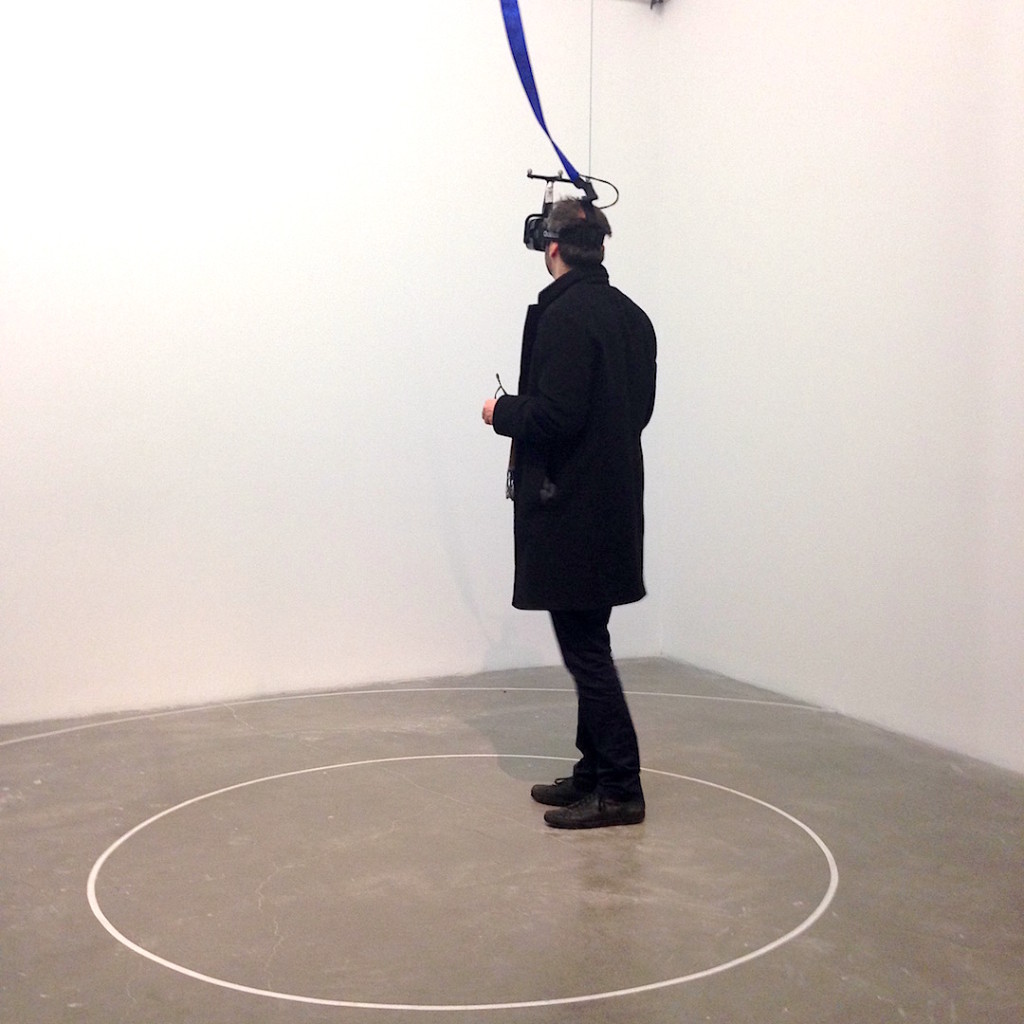
Daniel Steegmann Mangrane (B. 1977, Spain), Phantom (kingdom of all the animals and all the beasts in my name), 2014-15, Virtual environment and Oculus Rift DK2, New Museum Triennial, “Surround Audience”, Photo by Katy Hamer of Artspace’s Andrew Goldstein, 2015
The human body has evolved over time and shown signs of advancement, but where does the ephemeral/corporeal skeleton fit into the context of the earth and geological materials? In both the works of Daniel Steegmann Mangrane and Ane Graff, the artists very differently try to insert themselves, and by default the viewer, into a realm that might feel more familiar and natural (if false and composed); one being a virtual reality and the other a painted fossil of sorts. History can be challenged while it is being made. Through outlets such as social media (Instagram, Twitter and Facebook) the acronym IRL (in real life) has taken on a buoyancy all its own. Images and text appear have the possibility to appear in real-time, space has found a way to compress and is smaller than ever before.
An Untitled (2014-15) video, shown in a projected loop, by Oliver Laric confronts humanity in an almost comedic or satirical way. Bodies and shapes merge into one another in an animation accompanied by an orchestrated soundtrack. It becomes monumental the more time is spent in observance. A sexuality is portrayed that mirrors the seamless quality of a clicked link opening a new window in an updated browser. Our perception of these animated objects is that they actually move and such is the case with the text on the screen when typing even if it is actually quite still, while fingers move and dart across the keys.
Another artist who was included in The Encyclopedic Palace (2013), is Eva Kotátková who makes environments with objects that are both two- and three-dimensional. Her approach is almost scientific. Her piece in the Triennial, Not What People Move But What Moves Them (2013), includes sculptures made by recognizable forms and bodies that activate the space. At the press preview, a figure lay on the ground, cradling a stone with leather purse handles. This image was the strongest in her install, as the proposed weight of the rock left the figure burdened, yet by choice as it was held with a desperation that automatically assigned value. As much of the work in Surround Audience examines, this literal and metaphorical weight is one that we all carry on a daily basis in the containment of our own virtual identities.

Ane Graff (b. 1974, Norway), The Blow, 2013, Oil on marble with pedestal, New Museum Triennial, “Surround Audience”, Photo by Katy Hamer, 2015
Surround Audience is not about answers, it is about consideration. This is both a strength and weakness as the only missing element is a dynamic sense of assuredness. The most decisive stance taken is by the curators themselves, who in their selections offer us the space for contemplation, overstimulation and passive participation. A Post-Internet reflection, if at times fuzzy, offers a valid glance into contemporary art made by artists actively engaged in a technologically inspired life, learning how to embrace and negate it. From Lauren Cornell:
“Surround Audience explores the effects of an increasingly connected world within our sense of self and identity along with earth’s form, social role and behavior. Many of the works in the show look really closely at our present moment, a time when culture has become more porous and encompassing. The metaphor that Ryan [Trecartin] and I use is ‘surrounded’. A lot of the works ask if it’s possible to opt-out of or bypass a society that feels increasingly corporatized and commercial. Ryan and I were drawn to artists with really distinctive and impassioned visions and I think you’ll feel that as you walk through the exhibition.”
Trecartin followed with, “I think that the show is in some way a venn diagram of where our interests overlap [including] ideas and different subject matters that we’ve been talking about for years now. When we started thinking of ideas around the show, it started with language and poetry. Eventually it evolved into thinking about how a lot of the artists we were interested in are also curators, or doing things in the world. The art world is a place they happened to be using to jump off into other things but isn’t necessarily their main focus. We wanted to think of it as an opportunity for the New Museum to be more of a jumping off point into the world rather than a place where things are taken and put into. An example being that the ad campaign [Extended Release (2015)] was made by K-HOLE, they are an incredible artist group. It is both an artwork and an advertising campaign. And then [we included] someone like DIS Magazine, who doesn’t show that often in this context. We really encouraged them to make a physical work and it’s amazing. Then we also wanted to think about the transition spaces as legitimate exhibition spaces. Ashland Mines‘ sonic work goes in the lobby, in the stairwells and into the bathrooms. In general [Surround Audience represents] thinking of transitional spaces in culture being important parts of contemporary art and the way the artists in the show are thinking.”
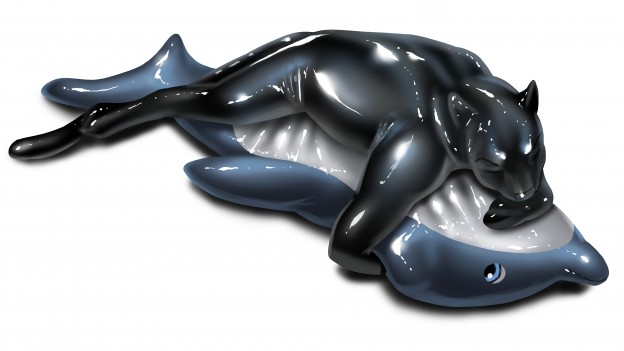
Oliver Laric (b. 1981, Austria), -Still from Untitled 2014-15, Video, sound, color 6 minutes, New Museum Triennial, “Surround Audience”, 2015, Image courtesy of AR/GE Kunst Galerie Museum, Bolzano, 2015
Surround Audience is on view at the New Museum until May 24th, 2015. Several related events have been planned including film screenings, artist talks and performances. For more information visit this page and scroll down for dates and times.
Additional artworks of note from Surround Audience are below selected by Katy Diamond Hamer.
- Tania Perez Cordova (b. 1979, Mexico), Meeting a stranger, afternoon, cafes, 2014, Fired terracota and borrowed SIM card, New Museum Triennial, “Surround Audience”, Photo by Katy Hamer, 2015
- Steve Roggenbuck (b. 1987, US), Somewhere in the bottom of the rain, 2011, Video, New Museum Triennial, “Surround Audience”, Photo by Katy Hamer, 2015
- Antoine Catala (b. 1975, France), Distant Feel, 2015, Materials variable, New Museum Triennial, “Surround Audience”, Photo by Katy Hamer, 2015
- Eva Kotakova (b. 1982, CZ), Not How People Move But What Moves Them, 2013, Various medium/performance, New Museum Triennial, “Surround Audience”, Photo by Katy Hamer, 2015
- Asli Cavusoglu (b. 1982, Turkey), Long Ago Person Found, 2014, Mixed media installation, 2014, New Museum Triennial, “Surround Audience”, 2015, Photo by Katy Hamer
- Ane Graff (b. 1974, Norway), The Blow installation view, 2013, Oil on marble, New Museum Triennial, “Surround Audience”, Photo by Katy Hamer, 2015
- Verena Dengler (b. 1981, Austria), Sponsors, 2001-14, Embriodery, New Museum Triennial, “Surround Audience”, Photo by Katy Hamer, 2015
- Eduardo Navarro (b. 1979, Argentina), Timeless Alex, Performance and sculpture, 2015, New Museum Triennial, “Surround Audience”, Photo by Katy Hamer, 2015
- Rachel Lord (b. 1986, US), Palimpsest, 2014, Acrylic on canvas, New Museum Triennial, “Surround Audience”, Photo by Katy Hamer, 2015
- Josh Kline (b. 1979, US), Freedom, 2015, Mixed-medium installation, New Museum Triennial, “Surround Audience”, Photo by Katy Hamer, 2015
- Olga Balema (b. 1984, Ukraine SSR), Untitled, 2015, Plastic, water, steel pipes, acrylic, New Museum Triennial, “Surround Audience”, 2015, Photo by Katy Hamer, 2015
- Tania Perez Cordova (b. 1979, Mexico), We focus on a woman facing sideways Evening, from the “Things in Pause” series, 2014, Bronze and borrowed gold earring, New Museum Triennial, “Surround Audience”, Photo by Katy Hamer, 2015
- Verena Dengler (b. 1981, Austria), Installation detail, 2001-14l, New Museum Triennial, “Surround Audience”, Photo by Katy Hamer, 2015
- Lawrence Abu Hamdan (b. 1985 Jordan), Tape Echo, 2013-14, Lightboxes, C-prints, tape echo machine, audio cassette player, audio cassette, headphones, New Museum Triennial, “Surround Audience”, Photo by Katy Hamer, 2015
- Tania Perez Cordova (b.1979, Mexico), New Museum Triennial, “Surround Audience”, Photo by Katy Hamer, 2015, “O”, 2014, Volcanic rock, blue cosmetic contact lens and resin, New Museum Triennial, “Surround Audience”, Photo by Katy Hamer, 2015
More soon!
xo

